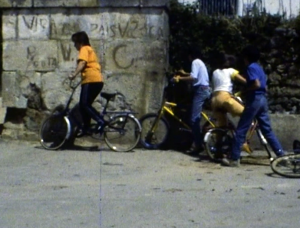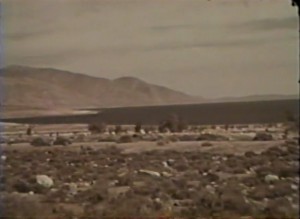"Under the Maple Leaf, by Hamilton H. Jones, ACL, is a partially refilmed and entirely reedited version of last year's award winner, Canadian Capers. A splendid picture a year ago, its new and additional sequences now bring to the film a photographic beauty plainly of the very first rank. A sequence of the morning mist rising from a lake deserves particular mention. Mr. Jones's considerable skill with his camera has increased in stature and may not yet have reached its full flowering. For this accomplishment his work has been given a place of honor in these selections. In the reluctant estimation of the judges, however, the editing and cutting of Under the Maple Leaf so far lagged behind its generally matchless beauty as to rob the film of its fullest emotional power. This factor only prevented Mr. Jones from repeating this year his full triumph of a year ago." Movie Makers, Dec. 1933, 523-524.
"Under the Maple Leaf, a new version of the perennial Canadian travel study by Hamilton H. Jones, ACL, is more beautiful and even more satisfying than its forerunners. Ineligible for current Ten Best, because of the fact that a small part of the present material has been viewed and listed in previous selections, the new release is included in the Honorable Mention category as a tribute to the dexterity with which the material, old and new, has been combined and the high quality of the added color sequences. The same flawless photography and clever sequencing which marked previous versions are again present. The disc sound accompaniment (in revised form) is deftly handled, making a thrilling addition to the film. Color is interspersed successfully with black and white sequences in a way that seems to obviate criticism of the mixture." Movie Makers, Dec. 1935, 553.
"A Vacation with Lucy Carlisle, Margaret Pinkham, Virginia Carlisle." oldfilm.org

Documental corto sobre el pueblo de Villa de Corres. El filme comienza con varios paisajes de los alrededores y planos de montañas y el río. A continuación se muestra el pueblo, aparecen casas, el río, calles y algunas partes características como el Castillo, el hospital, la iglesia de San Esteban, el bebedero, la fuente , la plaza, etc. También aparecen algunas personas mayores y niños por las calles. Se comenta que es un pueblo con una población de 30 habitantes pero que es uno de los pueblos más longevos de la provincia de Álava.
Short documentary about a town called Villa de Corres. The film begins with several landscapes of the surroundings and shots of the mountains and the river. Then the film shows the town, houses, the river, streets, and some landmarks like the Castle, the hospital, the San Esteban church, the drink fountain, the fountain, the square, etc. Some older persons and children are also seen. It is said that the town only has a population of 30 persons, but that it is one of the longest-living towns in the Alava province.
Scientific documentary
Symbiosis and protective systems of decapods
È un film scientifico che nella cornice di visioni di suggestiva bellezza, dei fondi marini, tratta dei sistemi di protezione e delle simbiosi di alcuni decapodi. È il primo film scientifico a passo ridotto che sia stato finora realizzato su questo argomento.
Questo film è stato realizzato nella Stazione Zoologica di Napoli, in tre mesi di assiduo lavoro e con ore ed ore di paziente attesa, subordinata alla capricciosa volontà di questi interessantissimi attori.
This is a scientific film that, within the frame of visions of suggestive beauty, of the depths of the sea, deals with the systems of protection and with the symbiosis of some decapods. It is the first scientific small-gauge film that has been made on this subject until now.
This film was made in the Zoological Station of Naples, in three months of assiduous work and with hours and hours of patient waiting, subordinated to the capricious will of these interesting actors.
—Notizario delle sezioni cinematografiche dei gruppi universitari fascisti a cura del ministero della cultura popolare, September 1938 p. 11
"Articles in Movie Makers have often advocated experimenting with travel continuities by selecting a single theme and illustrating it with sequences made in many different countries. The entertainment value of this method is beautifully illustrated by Water, filmed by B. H. Blood, ACL. This picture is made up of sequences of water, waterways, wells and ice in a variety of places in the world and ends with a sequence in the home of the maker. Any emphasis on mechanics which this theme might seem to entail is entirely obviated by the dramatically interesting scenes that Mr. Blood selected to illustrate his idea." Movie Makers, Dec. 1932, 561-562.
"The film Water, 400 ft., 16mm which took a first award by the unanimous vote of the judges in a recent interclub movie contest, was drawn from more than 7500 feet of film, exposed over a period of nearly four years. It is a splendid example of the synthesized short subject, shrewdly built up from scattered material around a simple continuity theme. For this film the continuity idea was found in the common phrase, "Water, water everywhere." Scenes of water in many places, in many forms and in many uses were compared and contrasted, each new sequence being connected to the last by a clever and effective title. The film was produced by B. H. Blood, ACL, in Hartford, Conn., who deserves every credit [or his intelligent adaptation of the best features of the professional subject." Movie Makers, July 1932, 322.
"Fred Hudson and Donal Michalsky of Los Angeles combined their talents to produce on black-and-white film the origin of a mountain storm and its eventual metamorphosis as a turbulent stream of water. The storm is depicted in gathering clouds moving swiftly among mountain peaks, thanks to ultra-speed photography. Highly artistic shots of the first raindrops falling on a pool indicate the break of the storm, and the camera then records in excellent rainfall shots the progression of the storm, forming of rivulets and their eventual building up to a mountain stream. The various moods are enhanced by the theme music on the sound track, excellently recorded." American Cinematographer, May 1951, 192.
"Glen H. Turner brings to us the song of the desert and the water wheel that turns continuously. We move from the melting snows on to the streams, lakes and rivers. The churning rivers, increasing in power and rhythm, brown with the soil of the desert, the power for the water wheel. The slow, great turning water wheel pours forth the brown water, the life of vegetation in the gray hills, casting its shadow, its red shadow in the setting sun" PSA Journal, Nov. 1958, 46.

Educational short film showing farming in California, and several mines and ghost towns in Nevada.
Total Pages: 11